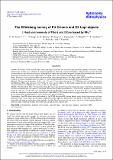Files in this item
The Effelsberg survey of FU Orionis and EX Lupi objects. I. Host environments of FUors/EXors traced by NH3
Item metadata
| dc.contributor.author | Szabó, Zs M. | |
| dc.contributor.author | Gong, Y. | |
| dc.contributor.author | Menten, K. M. | |
| dc.contributor.author | Yang, W. | |
| dc.contributor.author | Cyganowski, C. J. | |
| dc.contributor.author | Kóspál, Á. | |
| dc.contributor.author | Ábrahám, P. | |
| dc.contributor.author | Belloche, A. | |
| dc.contributor.author | Wyrowski, F. | |
| dc.date.accessioned | 2023-04-20T09:30:07Z | |
| dc.date.available | 2023-04-20T09:30:07Z | |
| dc.date.issued | 2023-04-17 | |
| dc.identifier | 283721781 | |
| dc.identifier | f5be2b78-a055-4556-93c8-b330c6a1cc6e | |
| dc.identifier | 85156218394 | |
| dc.identifier.citation | Szabó , Z M , Gong , Y , Menten , K M , Yang , W , Cyganowski , C J , Kóspál , Á , Ábrahám , P , Belloche , A & Wyrowski , F 2023 , ' The Effelsberg survey of FU Orionis and EX Lupi objects. I. Host environments of FUors/EXors traced by NH 3 ' , Astronomy & Astrophysics , vol. 672 , A158 . https://doi.org/10.1051/0004-6361/202244911 | en |
| dc.identifier.issn | 0004-6361 | |
| dc.identifier.other | ArXiv: http://arxiv.org/abs/2302.03371v1 | |
| dc.identifier.other | ORCID: /0000-0001-9830-3509/work/140829672 | |
| dc.identifier.uri | https://hdl.handle.net/10023/27436 | |
| dc.description | Funding: Zs.M.Sz. acknowledges funding from a St Leonards scholarship from the University of St Andrews. This project has received funding from the European Research Council (ERC) under the European Union’s Horizon 2020 research and innovation programme under grant agreement No 716155 (SACCRED). | en |
| dc.description.abstract | Context FU Orionis (FUor) and EX Lupi (EXor) type objects represent two small but rather spectacular groups of low-mass, young, eruptive stars. In both cases, outbursts of several magnitudes are observed, which are attributed to enhanced mass accretion from the circumstellar disc onto the central protostar. Although these objects are well studied at optical and near-infrared wavelengths, their host molecular environments are poorly explored because of the scarcity of systematic molecular line observations. Aims We aim to carry out the first dedicated survey of the molecular environments of a large sample of FUors and EXors, observing a total of 51 sources, including some Gaia alerts, to study the ammonia (NH3) emission in their host environments. Methods We observed the ammonia (J, K) = (1,1), (2,2), and (3,3) inversion transitions at ~23.7 GHz in position-switching mode using the Effelsberg 100-m radio telescope. For 19 of the 51 sources in our sample, we derived H2 column densities and dust temperatures using archival Herschel/SPIRE data at 250 µm, 300 µm, and 500 µm. Results We detected the NH3 (1,1) transition toward 28 sources and the (2,2) transition toward 12 sources, while the (3,3) transition was detected towards only two sources in our sample. We find kinetic temperatures between ~12 K and 21 K, ammonia column densities from 5.2 × 1013 cm−2 to 3.2 × 1015 cm−2, and fractional ammonia abundances with respect to H2 from 4.7 × 10−9 to 1.5 × 10−7. These results are comparable to those found in infrared dark clouds (IRDCs). Our kinematic analysis suggests that most of the eruptive stars in our sample reside in rather quiescent (sonic or transonic) host environments. Conclusions Our NH3 observations and analysis of the SPIRE dust-based H2 column density maps confirm the presence of dense material towards seven sources in our sample; additional sources might also harbour dense gas based on their NH2 (2,2) detections, potentially indicating an earlier phase than originally classified. Based on our results, we suggest that observations targeting additional molecular lines would help to refine the evolutionary classification of eruptive stars. | |
| dc.format.extent | 19 | |
| dc.format.extent | 1835425 | |
| dc.language.iso | eng | |
| dc.relation.ispartof | Astronomy & Astrophysics | en |
| dc.subject | Stars: pre-main sequence | en |
| dc.subject | Stars: low mass | en |
| dc.subject | Stars: formation | en |
| dc.subject | Stars: FU Orionis objects | en |
| dc.subject | Stars: EX Lupi objects | en |
| dc.subject | Molecular data | en |
| dc.subject | QB Astronomy | en |
| dc.subject | QC Physics | en |
| dc.subject | DAS | en |
| dc.subject | MCC | en |
| dc.subject.lcc | QB | en |
| dc.subject.lcc | QC | en |
| dc.title | The Effelsberg survey of FU Orionis and EX Lupi objects. I. Host environments of FUors/EXors traced by NH3 | en |
| dc.type | Journal article | en |
| dc.contributor.institution | University of St Andrews. School of Physics and Astronomy | en |
| dc.identifier.doi | 10.1051/0004-6361/202244911 | |
| dc.description.status | Peer reviewed | en |
| dc.identifier.url | http://arxiv.org/abs/2302.03371 | en |
This item appears in the following Collection(s)
Items in the St Andrews Research Repository are protected by copyright, with all rights reserved, unless otherwise indicated.

